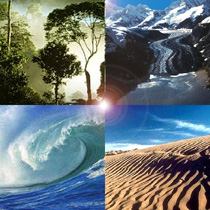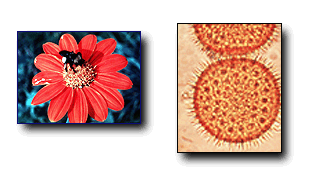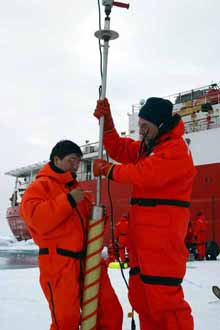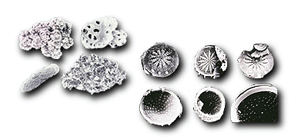Paleoclimate Proxies
Environmental recorders are used to estimate past climatic conditions and thus extend our understanding far beyond the 100+ year instrumental record. "Proxy" records of climate have been preserved in tree rings, locked in the skeletons of tropical coral reefs, extracted as ice cores from glaciers and ice caps, and buried in laminated sediments from lakes and the ocean.
Corals build their hard skeletons from calcium carbonate (CaCO3), a mineral created from dissolved calcium (Ca) and carbonate (CO3) in sea water. The carbonate contains isotopes of oxygen, as well as trace metals, that can be used to determine the temperature of the water in which the coral grew long ago. These temperature recordings can then be used to reconstruct the climate at the time when the coral lived.
Learn more about the study of corals and past climate by visiting:
Read the following sections at the site: (1) "Corals and the threat of global climate change" ; (2) "Collecting Coral Cores" - make sure you watch the quicktime movie of the coral sampling; and (3) "Data from a few reefs around the world".
All flowering plants produce pollen grains. The pollen grains distinctive shapes can be used to identify the type of plant that created them. Since pollen grains are well preserved when they sink and are buried in sediment at the bottom of a pond, lake or ocean, an analysis of the pollen grains in each layer of sediment tell us what kinds of plants were growing at the time the sediment was deposited. We can then make a good guess at what the climate was like when the pollen grain was buried based on the type of plant pollen found in each layer.
To learn more about fossil pollen and the past climate, please visit the following:
- Fossil Groups: Spores and Pollens, U.S. Geological Survey (USGS)
Read the section on "What are Spores and Pollen Grains?" How small are these spores and pollen grains?
Since tree growth is influenced by climatic conditions, patterns in tree-ring widths, density, and isotopic composition reflect variations in their surrounding climate. In temperate regions (regions where there is a spring, summer, fall, and winter) where there is a distinct growing season, trees generally produce one ring a year, and thus record the climatic conditions of each year. Trees can grow to be hundreds to thousands of years old and can contain single year records of climate for centuries to over a thousand years.
To learn more about tree rings and past climate please visit the following:
- Laboratory of Tree Ring Research at the University of Arizona
Read the section "Tree Rings Basics" at the University of Arizona site.
Located high in mountains and in polar ice caps, ice has accumulated from snowfall over many thousands to hundred of thousands of years. Scientists can drill through this deep ice and collect ice cores from areas in Greenland and Anarctica. These cores contain things such as dust, air bubbles, or isotopes of oxygen, that can be analyed to interpret the past climate of that area.
To learn more about ice cores and past climate visit the following site:
Make sure to read the entire website.
Billions of tons of sediment accumulate at the bottom of the ocean and lake basins each year. Scientist drill cores of sediment from the basin floors and bring them back the surface to analyze. Ocean and lake sediments have imbedded in them tiny fossils that are used to interpret past climates.
To learn more about ocean & lake sediments can be used to determine past climate, please visit the following:
- Ocean Drilling Program- funded by NSF with 22 international partners
- IMAGES- International Marine Global Changes Study international collaboration
Now proceed to C. Has the Earth's Climate Changed Over the Past 1000 Years?





